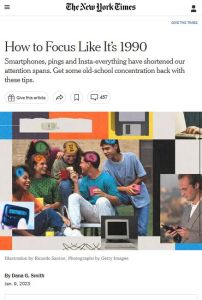
How to Focus Like It’s 1990
Smartphones, pings and Insta-everything have shortened our attention spans. Get some old-school concentration back with these tips.
Recommendation
Imagine sitting at your desk in your office. You pull up a spreadsheet and start working. Then you check your email. Back to the spreadsheet. Now you open a web page to get some information. Is your phone on silent? Better check for a message then. What were you doing again? Ah, the spreadsheet. How do you think your concentration compares to that of a typical knowledge worker? Do you think you switch tasks more often than you did 10 years ago? In this New York Times article, science writer Dana G. Smith describes the inattention of the digital age, along with some possible solutions.
Summary
About the Author
Dana G. Smith writes about science, health and society. Her work has appeared in Scientific American, The New York Times, Popular Science, The Atlantic, STAT, Vice, and other publications.








Comment on this summary